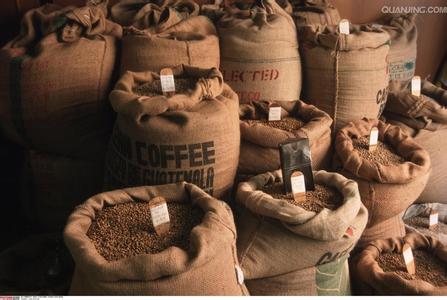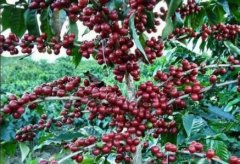A brief introduction to the planting situation, geographical location, climate and altitude of Taiwan's high-quality coffee with mellow flavor.

In 1941 (the 16th year of Rizhaohe), most of the raw beans were shipped back to Japan. The coffee planting area in Taiwan has reached 75 hectares, and in its heyday it was known as "the largest coffee factory in the far East". In 1945 (Rizhaohe 20 years), the area of coffee cultivation in Taiwan expanded to 113 hectares after the war. After the surrender of Japan, Taiwan was restored, and the national government strongly advocated the reclamation of fertile land and the cultivation of cash crops. The aborigines of Alishan even wanted to use the countryside or mountains to grow some food to feed their stomachs. No one wanted to grow coffee that tasted as bitter as life, so Taiwan coffee gradually declined and was gradually forgotten by people. In 2000 (1989), it was not until it was publicized by the Taiwan government and the strong support of the Chiayi county government that local farmers began to grow coffee again, and Taiwan coffee gradually revived and developed well in recent years, and was loved by more and more people.
The Taiwan Coffee Association was formally established in 2002 (October 1992). Its purpose is to strengthen the cooperation and exchanges between Taiwan's coffee industry and the rest of the world, to enhance the cooperation and exchanges between Taiwan's coffee industry and coffee lovers, and to provide professional knowledge and information about coffee. create Taiwan's unique coffee culture and enhance its international status.
Alishan Mafeel coffee belongs to alpine coffee and belongs to the high-quality boutique coffee in Taiwan. It ranks first in Asia and eighth in the world. Coffee trees are mainly planted in southern Taiwan, such as Alishan in Chiayi County, Taiwan. because of its high altitude, Alishan is not only suitable for growing tea, but also more suitable for growing coffee. It belongs to the boutique coffee in coffee.
Mafeel is a language taken from the Zou people of the Alpine nationality in Alishan, which means "delicious". Alishan is the area where coffee is grown, while the coffee is grown by the Zou people themselves, and it is also named Mafeel, and the coffee grown belongs to Taiwan coffee. Due to the low production of Mazu coffee in Alishan, Taiwan coffee is scarce.
Alishan Mafeel is planted in the Alishan Mountains, and the Alishan Mountains are uniquely located in the global coffee belt. Because of the high altitude and the temperature difference of more than 10 degrees between day and night, the coffee beans produced are of the best quality, with plump fruit grains, thick pulp, sweet and mellow taste, sweet taste, no astringency, no bitterness and no acidity. It perfectly presents the delicious coffee with the best quality and the most unique flavor. "Zhenggang" native flavor of "Taiwan Alishan Maha Coffee".
Alishan coffee is the most special and superior coffee in Taiwan, and its output is relatively small, and it is precious because it is rare. Alishan, located 75 kilometers east of Chiayi City, Taiwan, is located above 2000 meters above sea level, adjacent to the Yushan Mountains and Yushan National Park in the east, surrounded by high mountains, with a cool climate, with an average temperature of 10.6 degrees Celsius in summer and 14.3 degrees Celsius in summer. the average temperature in winter is 6.4 degrees Celsius. The taste is not bitter and astringent, and the flavor is mellow and rich. Alishan's unique climate and altitude conditions give birth to high-quality mountain tea, orchids and what the Japanese call the best horseradish (Washami). The number one coffee in Taiwan is not in Gukeng or Dongshan, but in Leye Village in Alishan.
Alishan coffee is the most special and superior coffee in Taiwan, and its output is relatively small, and it is precious because it is rare. Alishan, located 75 kilometers east of Chiayi City, Taiwan, is located above 2000 meters above sea level, adjacent to the Yushan Mountains and Yushan National Park in the east, surrounded by high mountains, with a cool climate, with an average temperature of 10.6 degrees Celsius in summer and 14.3 degrees Celsius in summer. the average temperature in winter is 6.4 degrees Celsius. The taste is not bitter and astringent, and the flavor is mellow and rich. Alishan's unique climate and altitude conditions give birth to high-quality mountain tea, orchids and what the Japanese call the best horseradish (Washami). The number one coffee in Taiwan [2] is not in Gukeng or Dongshan, but in Leye Village in Alishan.
The varieties of Alishan coffee are grown in Arabica. This kind of coffee grows in a harsh environment. Taiwan is located in the subtropics. The temperature is higher all the year round, and coffee trees like shade. If coffee trees are planted alone, they may be killed by the strong sun. The Ali Mountains are covered with forests and there are many betel nut trees, so most of his coffee trees are planted in the betel nut garden, because the betel nut trees grow fast and have luxuriant branches and leaves. It can not only absorb the sun but also get shade early, which is very suitable for the growth of coffee. In the coffee garden where Ali Mountain went, the coffee trees are all hidden in the shade of the betel nut trees. Coffee trees are also very strong, and the coffee produced is relatively good. Coffee trees are planted and coffee plants emit different fragrances and tastes depending on where they are planted, and they are still coffee varieties with great personality. Alishan coffee in Taiwan has become very popular in recent years.
There are typhoons in Taiwan every year, and the roots of coffee trees generally do not go very deep into the soil. Once they encounter a strong typhoon, they will fall down. Putting betel nuts in the coffee garden can not only protect them from the shade, but also block the wind. The flowers of the coffee are on the top, while the bottom is fruitful because of the uneven sunshine. Because the bottom is exposed to sunlight and receives a higher temperature of the soil, it blossoms earlier and bears fruit earlier. The lower part of the plant blossoms and bears fruit later because of the strong wind and the lower temperature. Unlike tropical Southeast Asian and African countries, coffee trees in Taiwan have uniform crown and bottom temperatures and can blossom and bear fruit at the same time. The ripening time of the fruits on coffee trees in Taiwan is uneven, and they can only be picked one by one, so coffee farmers work hard to pick beans when picking coffee, and they can only pick ripe fruits first, and then pick them after a few days, which wastes a lot of time for coffee farmers. on the other hand, the coffee of one tree blossoms at different times, bears fruit at different times, and is picked at different times, which makes the aroma of Alishan coffee particularly rich. [3]
The output of coffee beans in Taiwan is small, but through the careful planting of farmers, high-quality coffee beans can be harvested. Coffee trees, including Alishan, Nantou, Yunlin, and other places have very unique coffee. Alishan coffee is planted by young people of the Alishan Zou people who return to their hometown. The annual output has reached 20 tons, supplying instant coffee and filter coffee.
Taiwan's coffee is very famous. The history of Taiwan coffee can be traced back to 1624. In the early days, the Dutch introduced coffee, but it was limited to Dutch internal drinking, so it could not be widely popularized. During the Japanese occupation in 1931, at that time, for the sake of their own needs and for the sake of Taiwan coffee, the Japanese invaders vigorously mobilized farmers to grow coffee, so many farmers lost fertile fields for growing rice. Although the coffee grown has a bumper harvest year after year, but the coffee has no profit and has lost its food, many coffee farmers have not been able to feed themselves by working all their lives. Mr. Kimura grows and cultivates in large quantities in the areas of Alishan, Nantou and Yunlin in northern Tainan.
Important Notice :
前街咖啡 FrontStreet Coffee has moved to new addredd:
FrontStreet Coffee Address: 315,Donghua East Road,GuangZhou
Tel:020 38364473
- Prev

A brief introduction to the Market Price of Mahi Fine Coffee varieties in Alishan, Taiwan
Alishan Mafeel is planted in the Alishan Mountains, and the Alishan Mountains are uniquely located in the global coffee belt. Because of the high altitude and the temperature difference of more than 10 degrees between day and night, the coffee beans produced are of the best quality, with full grains, thick pulp, sweet and mellow taste, sweet, non-astringent, not bitter, not sour, and perfectly showing the taste of coffee.
- Next

A brief introduction to the cultivation of boutique coffee in Latin America, geographical location, climate and altitude
Mexico (Mexico) aroma 3 points of brightness 4 points of mellow 3 points of flavor 4 points of aftertaste 4 points suitable for baking: Full cityfull city, baking to the beginning of the pot, whether mixed with the formula to make Espresso or brewing single product, Mexican coffee beans can be said to have a unique flavor. Mexican coffee from Cottpe and Veracruz in the north to Plema in the central Oaxaca region.
Related
- Detailed explanation of Jadeite planting Land in Panamanian Jadeite Manor introduction to the grading system of Jadeite competitive bidding, Red bid, Green bid and Rose Summer
- Story of Coffee planting in Brenka region of Costa Rica Stonehenge Manor anaerobic heavy honey treatment of flavor mouth
- What's on the barrel of Blue Mountain Coffee beans?
- Can American coffee also pull flowers? How to use hot American style to pull out a good-looking pattern?
- Can you make a cold extract with coffee beans? What is the right proportion for cold-extracted coffee formula?
- Indonesian PWN Gold Mandrine Coffee Origin Features Flavor How to Chong? Mandolin coffee is American.
- A brief introduction to the flavor characteristics of Brazilian yellow bourbon coffee beans
- What is the effect of different water quality on the flavor of cold-extracted coffee? What kind of water is best for brewing coffee?
- Why do you think of Rose Summer whenever you mention Panamanian coffee?
- Introduction to the characteristics of authentic blue mountain coffee bean producing areas? What is the CIB Coffee Authority in Jamaica?

